I heard somewhere (although I can’t vouch for whether it’s true) that The Juniper Tree is the story most often omitted or edited from collected editions of the Brothers Grimm on grounds of taste. If anybody wanted to argue that fairy tales aren’t suitable reading material for young children, they might well point to this one. It contains the murder of an innocent child and the cannibalisation of his remains by his family. Gory stuff, but it also contains resurrection and metamorphosis and some serious avian weight-lifting. You can read a version of it here…
http://www.surlalunefairytales.com/authors/grimms/47junipertree.html
There’s an English sister story to the German Juniper Tree. It’s called The Rose Tree and it swaps the little boy at the centre of the story for a little girl, swaps summer for winter, and swaps the happy ending for an almost recklessly sad one.
http://www.authorama.com/english-fairy-tales-5.html
I can’t decide which of the two I like the most. I was going to write and draw about just one, but in the end there were images from both that stuck too hard. Thinking about them in tandem, they’ve become jumbled up in my head, and the little hero and heroine have become a kind of Hansel and Gretel pairing wandering about in simultaneous woods. This picture shows the little boy from The Rose Tree, who never quite manages to cease weeping after his mother murders his sister…
Botanists beware that the rose and juniper trees in these pictures don’t much resemble the actual plants in question. But then, neither do the ones in the story. These trees are very much living beings, involved in the lives of the families in whose orchards they grow. The juniper tree, in particular, actually engenders the little boy who we follow through the story. His mother is desperate for a child, and after eating the berries from the tree she conceives. Lo and behold, nine months later a little boy is born, red as blood and white as snow. Upon giving birth to the boy, the new mother is so very happy that she lies down under the juniper tree and dies. The imagery is so strong (enchanted fruit, immaculate conception, sacrifice of the innocent, resurrection…) it could be bent into a metaphor for all kinds of things. But personally I find these two stories very resistant to interpretation. I enjoy them more just as they are: more like tone poems than parables. And the tone isn’t as horrifying as the gruesome events might imply. Instead it’s sad and wistful, because it’s heart-breaking to follow a little child through such grim times. The world can be a cruel and unkind place, the stories seem to warn, but you can still snatch goodness back from it.
I think that’s why I like these stories so much, and why I like the (sadder) ending of The Rose Tree the better of the two. Magic in The Rose Tree is not a wand-waving fixative, it’s a part of the world for good or bad. I’m interested in magic in stories as a kind of expressionism – a means of communicating through fantastical imagery the relationship between a person’s emotional world and the physical world in which they find themselves. The wicked stepmother gets her punishment at the end of both stories, but to me they’re not about good triumphing over evil. They’re about a dignified emotional response to the horrific things people are capable of. I find The Juniper Tree the slightly weaker of the two, because the narrative feels at times like it’s trying to undo some of that. At the end, the little red-as-blood boy springs back to life and the actions of the stepmother are presented as the direct work of the devil. This feels tacked-on to me, a reassurance to child readers that the dead boy is okay really, and that a mother would never be capable of committing such crimes. But you only have to read the newspaper, etc…
All that said, my favourite passage in either story is at the end of The Juniper Tree, where the stepmother realises she’s about to receive her punishment and feels like she’s catching on fire. You don’t get many passages in fairy stories where the narration gets inside a character’s head like that.
These last pictures might need a bit of explanation, so that you can tell what they’re meant to contain. After their deaths, the children in both stories are transformed into birds by their respective trees. The rose tree makes of the little girl’s bones a bird born out of rose petals, and the juniper tree opens wide its trunk to shoot out flames and smoke and a beautiful bird made from the remains of the blood-red boy. I’ve drawn this latter as a kind of firebird, since he was created in the fire. Likewise I thought it would be fun to try to draw a bird made from a rose flower. I think it’s a bit beyond me to draw that effectively, but here are a couple of attempts nevertheless…
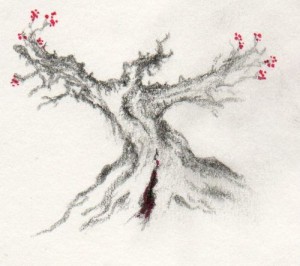
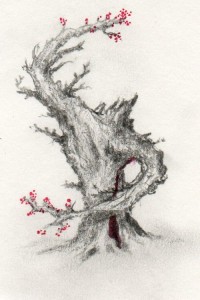

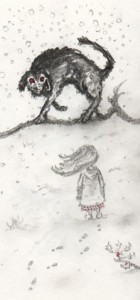
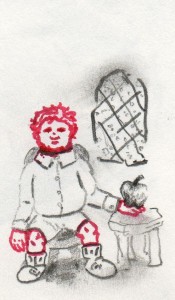

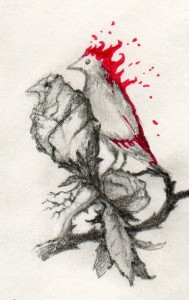
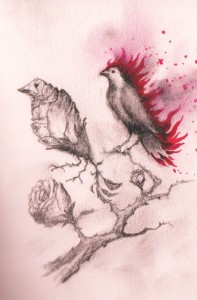
Hi,
I’ve haven’t read either story before and the stepmother chopping the kids head off was unexpected… interesting stories 🙂
Hi Sandra,
It’s quite a nasty surprise when it happens, isn’t it? I once saw a puppet version of The Juniper Tree, and the volume of the audience’s gasp when the boy’s head came off said it all!
Thanks for commenting,
Ali